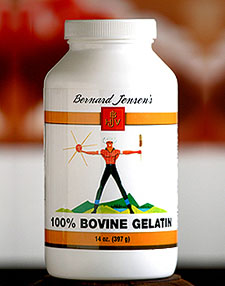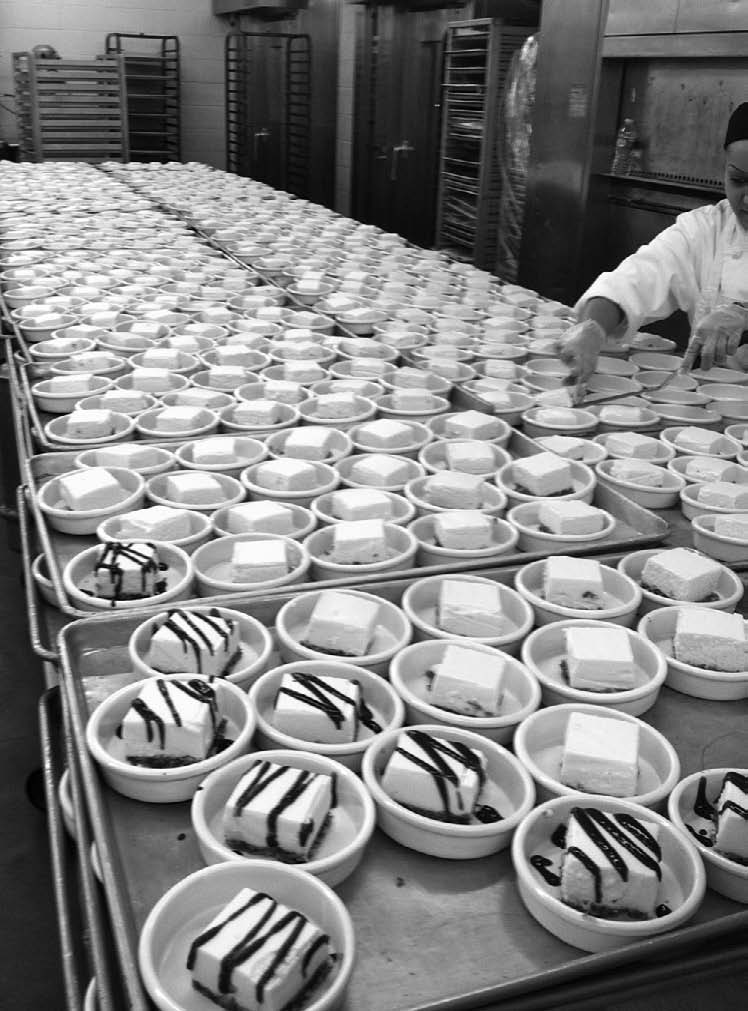Every year, Radiant Life packs up shop for a long awaited expedition to the Weston A. Price Foundation's annual Wise Traditions Conference. Among boxes full of clinking supplement bottles, carefully aligned coconut oil jars, and meticulously organized, glossy books you will always spot us with an entire case of bovine gelatin in tow. For what you might ask? Well, for the joyous mass-preparation of Sally Fallon’s own All-Raw Cheese Cake to serve to all attendees. Though the conference is not until November, we have already found ourselves licking our lips in anticipation of the event. Thus in this week’s Recipe Tuesday, we will share with you information about the misunderstood health benefits found in our obscure case of gelatin, and also reveal the treasured cheese cake recipe so that you may serve up a delectable slice for yourself. When we see you at the Wise Traditions Conference in Santa Clara in the Fall, be sure to let us know how your cheese cake compares!
Gelatin...It's Not What You Think
Many people have a misconstrued idea about just what gelatin is. When we hear the word, many of us picture a fluorescent green mold, punctuated with chunks of floating mystery ingredients as it jiggles methodically on the table at a block-party. Others, in the age of skinless, boneless, styrofoam-wrapped chicken breasts, find the idea of nutrient-dense bones to be utterly off-setting. Or we think of gelatin as a useful thickener in a crunch when our kitchen experiments have gone awry and need a quick fix. However, unbeknownst to most, the extensive benefits of adding gelatin to the diet have been amply researched and are far too meaningful to be ignored. Gelatin itself has been used supplementally, in cooking, tonics and remedies for thousands of years. Much of the healing value of comforting bone broths is attributed to the phenomenal nurturing power of the gelatin itself (explaining why we always strive for gelled stocks in traditional cooking.) The first documented use of gelatin is referenced as far back as 204 A.D. in Chinese texts, wherein there is evidence that gelatin was used as a treatment to halt hemorrhage or bleeding.
There’s Always Room for...Bovine Gelatin?

Let’s take a pause for a quick, not-too-painful physics lesson. Most raw foods are structured to be colloidal and hydrophillic- meaning that when they are consumed, they attract fluids (in the form of digestive juices) which allow for rapid and easy digestion. When colloids have been heated, such as during the common human practice of cooking, they often precipitate and become hydrophobic, or liquid repellent. This characteristic makes the process of digestion far more difficult, leading to chronic digestive strain. Gelatin is a unique food in that it maintains its hydrophillic properties even after it has been heated, thus boosting attraction of gastric juices. This gives gelatin a wonderful ability to ease irritations in the digestive tract such as peptic ulcers, infections and even (in more recent studies) cancer.
The amino acids in gelatin, namely glycine, also work to boost gastric secretions. It has been newly revealed that many problems with indigestion are correlated to too little gastric acid- counterintuitive for those individuals who have been munching down on Tums wafers for years. Gelatin therefore helps in maintaining appropriate digestive function through acid secretion and attraction in a balance that is crucial for the absorption of many nutrients including calcium, folic acid, B vitamins and magnesium.
Bovine gelatin, while not a complete protein in and of itself, contains 20 of the 22 amino acids and acts as a protein sparer- complementing and enhancing the digestion of complex proteins when consumed in tandem. If you are an individual who struggles with reaching adequate protein intake, be sure to add gelatin to your diet to reap all the benefits of the proteins that you do consume.
“Gelatin may be used in conjunction with almost any diet...The use of hydrophilic colloid (such as gelatin) in the dietic treatment of gastric complaint, is frequently sufficient in itself to rectify what are apparently serious conditions.” -M. Pottenger, JR., MD Hydrophilic Colloid Diet
J-E-L-L-O, the N-O, N-O
As we find with most ingredients on the market today, not all gelatin is created equal. Jello is a nasty, chemically-infused concoction of sweeteners, flavorings and pork gelatin that has been collected from the skin of malnourished pork, heated and bleached for mass production. Sally Fallon has recommended Bernard Jensen Bovine Gelatin, derived from the highest quality grass-fed cows. While all gelatin naturally contains minute amounts of glutamic acid/MSG, this particular product is handled in a way that virtually eliminates this factor. Bernard Jensen Gelatin is in fact considered so safe and beneficial that it is a key ingredient in the Nourishing Traditions Kit for Homemade Baby Formula providing infants with optimal ease of digestion and nutrient enhancement. And yes, if you cannot give up those jiggly fruit flavored desserts, there is certainly a healthy alternative to make your own jello with freshly squeezed fruit juice and bovine gelatin.
Sally Fallon's All-Raw Cheese Cake
Gelatin can thus be incorporated into the diet in a variety of ways- add it to soups, sauces, gravies, breakfast smoothies, creams, and yogurts for protein and digestive benefit. Or you can eat lots of this All, Raw Cheesecake recipe... just be sure to do so in good-spirited moderation so that you can share it with friends. Enjoy!
2 cups crispy almonds* or Better Than Roasted Raw, Sprouted, Organic Almonds
1 cup pitted dates
4 cups cream cheese, preferably homemade, softened
4 eggs separated at room temperature
1 1/4 cups milk, preferably raw
2 tablespoons gelatin
1/2 cup raw honey
1 tablespoon vanilla
pinch sea salt
*Crispy Almonds: Prepare these in advance by mixing 4 cups skinless with salt and filtered water and leave in a warm place for at least 7 hours or overnight. Drain in a colander. Spread on a stainless steel baking pan and place in a warm oven (n more than 150 degrees) for 12 to 24 hours, stirring occasionally until completely dry and crisp. Separate 2 cups for this recipe, and store remaining in airtight container.
In a food processor, process dates and almonds until they form a sticky mass. Press into a buttered 9- inch by 13-inch pyrex pan to form a crust. Put egg yolks and milk in a sauce pan, beat lightly, sprinkle with gelatin and warm slightly until gelatin is dissolved. In a food processor, combine cream cheese, honey and vanilla and process until smooth. Add yolk mixture and process until smooth. Transfer to a bowl and place in refrigerator while beating eggs. Beat egg whites with a pinch of salt until stiff, fold into cream-cheese mixture and pour into crust. Chill several hours before serving.
For detailed instructions on how to make your own homemade cream cheese for the optimal health benefit and taste, see page 86 of Nourishing Traditions, by Sally Fallon. If you choose to use products that are store-bought, be sure to use quality ingredients that are organic, raw and as unprocessed as possible.
Subscribe to our blog for more recipes and to explore our other popular posts on important wellness topics!
Sources:
Photo: Chefs preparing Sally Fallon's All-Raw Cheese cake at the 2011 Wise Trafitions Conference/ As appearing in Wise Traditions quarterly journal, Winter 2011.
"Why Broth is Beautiful: Essential Roles for Proline, Glycine and Gelatin." By Kaayla T. Daniel PhD, CCN
Nourishing Traditions, Sally Fallon
Gelatin in Nutrition and Medicine, N.R Gotthoffer
Hydrophyllic Coilloid Diet, M. Pottenger, JR., MD

